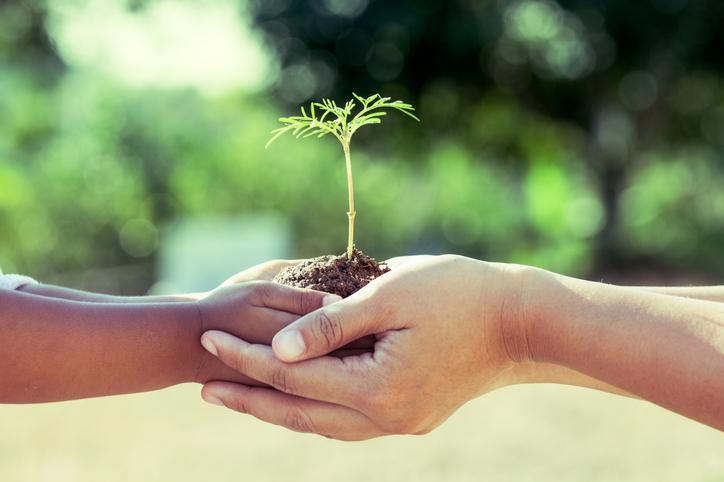Submitted by Thurston County Public Health and Social Services
Spring reminds us that we live in a truly beautiful place—with water views, mountain vistas, and more places to explore than one life can achieve. But let’s face it, much of our outside time is spent, and best memories created, in our own back yards. Spring gives us the opportunity to spiff up the yard and get ready for dirty hands and wide-brimmed hats!
Stay Safe
 Backyard chickens and ducks are fun to raise and also help control insects in the yard, especially slugs! Make sure you know how many are allowed in your neighborhood (usually up to 5 hens and no roosters in city limits) and keep them fenced-in for protection. Thorough washing with soap and water after handling animals, their feed, and even water bowls is the best protection against illness and skin irritations. Supervise younger children and make sure there is no snuggling or kissing, no matter how cute or tempting it might be!
Backyard chickens and ducks are fun to raise and also help control insects in the yard, especially slugs! Make sure you know how many are allowed in your neighborhood (usually up to 5 hens and no roosters in city limits) and keep them fenced-in for protection. Thorough washing with soap and water after handling animals, their feed, and even water bowls is the best protection against illness and skin irritations. Supervise younger children and make sure there is no snuggling or kissing, no matter how cute or tempting it might be!
Avoid hazardous bug and weed control products and invest in a long handled weed tool or propane weed torch. Take shoes off at the door to help avoid tracking toxins indoors where they stick around in house dust.
Choose slow-release fertilizers for the lawn and garden to prevent nutrients running off into nearby lakes and streams and avoid the use of weed and feed products. Separate fertilizing and weed control and choose the safest product for each.
Whether you are a new or experienced gardener, there is always much to learn! Growsmartgrowsafe.org is a great website that can help you choose the safest gardening products.
Grow Beauty
Choose plants that do well in the growing conditions that you have in your yard. This will help your plantings thrive and take less work and resources to grow. Another way to save effort and resources is to group plants with similar watering needs together. Group water-loving plants in a visible location to help you keep up with their water demands.
There are many flowering plants that do well in our area and don’t need much effort. Native plants are well-adapted to thrive in our growing conditions and won’t need fertilizers, or bug and disease controls. Some of our natives with beautiful spring flowers include: Red-flowering current, Oregon Grape, False Lily of the Valley, Mock-Orange, Bald Hip Rose, Serviceberry, Salmonberry, and so many more!
There are plenty of lovely, non-native plants that also thrive in our growing conditions. Hybrid Roses just need a sunny spot and good air flow, Strawberry Shrub and Sunrose will love a warm and dry spot, and Alyssum and Dusty Miller will do better in at least partial shade. For more easy-to-grow, plant ideas see, Common Sense Gardening’s plant list.
Weeds are much easier to prevent than control. A thick layer of mulch is the best weed prevention. Non-planted areas like edges and pathways can be covered in weed cloth or cardboard and then covered in up to 4 inches of mulch. Purchase certified, weed-free-mulch or collect grass clippings and leaves to create a layer of mulch around plants and any non-planted spaces in your yard. In addition to controlling weeds, mulch helps conserve water and adds organic matter to your garden over time.
An insect-free yard is not practical or desirable! Many insects play an important role in keeping the garden healthy and strong. Encourage “good bugs” that will outcompete “bad bugs” by growing flowers and leaving at least some areas along the edges of your yard “wild.” Flowers in the daisy and sunflower families are particularly good at attracting beneficial insects. Sunflowers, poppies, yarrow, cosmos, coreopsis and black-eyed susans are just a few of our favorites.
Grow Food
Herbs are a great way to get started growing edibles and do well in small containers on a deck or can be used as a groundcover along planted edges. Marjoram, thyme, sage and rosemary all do well in our climate and will need at least some sun. As our many farmer’s markets can attest, vegetables do well locally, especially greens like spinach, kale and chard, lettuces, and all of the many varieties of squash.
Berries also thrive in our area. Blueberries are beautiful year-round, with their red stems and deciduous leaves, while strawberries make a wonderful ground cover given enough sunshine. Fruit and veggies will need water in the dry months so invest in soaker hoses or drip lines and make sure to mulch well to prevent weeds and retain moisture.
Learn More
Common Sense Gardening Guides are helpful resources for more information on how to garden and protect drinking water. Sign up for Thurston Home and Garden, Thurston County Public Health and Social Services’ bi-monthly newsletter at 360-867-2674 or text 2282 to get ideas for home and garden tips and learn more about the Master Gardeners help clinic.
Stay safe and grow fun!



















































